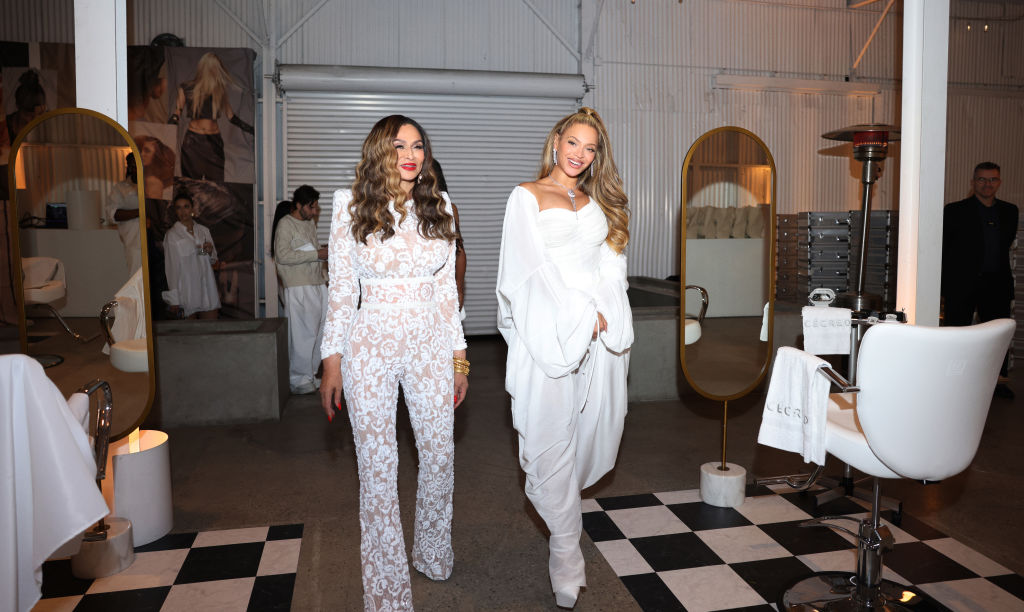“I Made History And I Deserve To Have It Printed” Trans Model Tracey Norman Talks About Passing In The Fashion Industry - Page 2
Share the post
Share this link via
Or copy link
These days, with the Laverne Coxes, Janet Mocks and Caitlyn Jenners of the world, the trans experience is less taboo and underground and more accessible to the mainstream. But, as you might imagine, that wasn’t the case in the mid 1970s.
And as hard it was for a trans person of any color, the difficulties of that existence was compounded by Blackness. Yet, despite all of this, Tracey “Africa” Norman (formally known as Tracy), managed to carve out a niche for herself in the fashion and modeling industries, passing for much of her career as she landed magazine and Clairol box colors.
You need only glance at Norman to see the striking resemblance she shares with another legendary model, Beverly Johnson. And that’s just how she was marketed back in the day, the next, younger version of Johnson, even though she is just two months younger.
In a recent interview with New York Magazine, Norman, who had practiced the art of “being both beautiful and invisible, finally explained how she broke in the modeling world, made history and how her career came to a standstill once her secret was discovered.
Check out a few highlights
Norman was born in Newark, New Jersey to a very glamorous and supportive mother and a father who was always trying to change her. Tracey said her “being effeminate” was always a point of contention with her parents. Her mother was accepting and her father thought he could change her.
“He tried everything he could. He bought me boxing gloves and was trying to teach me how to box. Kept hitting me on one side of my head.”
For as long as she can remember, Norman said, “it just seemed like I was living in the wrong body. I always felt female.”
Thankfully, her friends who were mostly girls, kept her relatively protected from bullying.
“For whatever reason, my karma did not attract violence. Name-calling sometimes.” She would closely observe their behavior. “I would watch how they sit, listen to how they talk, how they communicate with each other. I would see how they walk. I would see how my mom would live her life and how she would move through the world.”
Tracey also speaks of being molested by a teenage boy when she was 5-years-old.
“I didn’t mind,” says Norman. “I went back a few times. I was very young. I didn’t know any better.” What bothered her more was finding out that a friend of the boy’s was hiding in the closet, watching. “I got mad because I thought it was personal,” she says. “That’s when I first got my experience of being called a fag.” But the insult didn’t exactly register with her. “In my head I was straight and I only liked men.”
When Tracey was six, the two separated and her father moved out. After junior high school, he wasn’t involved in her life.
Norman, now 63, did reconnect with her father when she was in her 40s. Boarding a bus from Newark to Penn Station, Norman noticed that her father was the one driving.
“I recognized him as my father; he did not recognize me,” says Norman. “I was like, ‘Daddy, it’s me.’ He was shocked to see me.” Years later, when her father was diagnosed with cancer and Norman started visiting him in the hospital, he came around. “He saw that I have done something very exciting with my life. I think he was proud of me at that point. He was more accepting.”
It wasn’t until she graduated high school in 1969, the first in her family to do so, that she told her mother that she was a woman.“She just opened her arms, gave me a big hug, and said that she knew, she was just waiting for me to come to her,” says Norman. “I had a moment where I realized what they mean when they say unconditional love.”
Months after she graduated, a beautiful woman approached Norman on the street. Norman didn’t recognize her but she recognized Norman.
“At the time we were both male and we weren’t the same class. I said, ‘Well, how did you do that?’ And she reached into her pocketbook and gave me birth control pills, told me not to take the dark-blue ones on the bottom, just take the first three rows on the top.”
When Norman started going to clubs like Third World and Up the Down Stairs, she became serious about her transition. There were many trans people there and she eventually started asking questions. They led her to a doctor who worked under the table on the Upper East Side of New York City.
“You would pay in cash and come back the following month and get another shot.”
A year after graduation, she felt like she could walk the streets and pass as a woman.
“It started small. It was no big, ‘I’m here!’ It was fantastic being myself. It felt so free.”
Still, Tracey was entering into dangerous terrain. Her friends who helped her transition had warned her about the dangers of her newfound freedom. So, everyday when she left the house she would pray for her safety.
“Please Lord, don’t let anybody disrespect me, call me a name, or try to embarrass me. And please don’t let this by the day.”
In a world where the lives of trans women was often violent, as it still can be today, the only option in the ’70s was to pass for survival.
In 1975, Norman was on her way to a fashion show at the Pierre Hotel. She came out of the subway and noticed a group of Black women she recognized from magazine spread standing on the corner.
“She waited for them to go inside, and then slipped in behind them. Through the door, into an elevator. “My mind just kept saying, ‘Follow them,’ After I got close enough to see what was going on through the door of the hotel room, I saw it was an interview,” she says. Near the end of the day, her turn finally came and she stepped up to the desk, where they asked for her name, phone number, and agency (which she didn’t have). The next day she got a phone call saying she’d been booked for a two-day shoot for Italian Vogue and the pay was $1,500 a day, more money than she’d ever seen. “My eyes popped out of my head!” says Norman. “I couldn’t wait to call my mom.” She didn’t realize until then that the people she’d met at the desk had been an editor from Italian Vogue, Basile designer Luciano Soprani, and photographer Irving Penn.”
Norman became the second African-American woman to grace the cover of Vogue, after Beverly Johnson.
Once she’d started modeling seriously, her friends advised her to just do her work and leave. They advised her to skip dinners with photographers and staying out late to go to huge parties.
When New York Mag, asked her how she managed to keep her secret in an industry that required her to take her clothes off, in public, she said: “Duct tape becomes a girl’s best friend. I had to do other things, yes. I’d like to keep some things private.”
Still, that didn’t mean that some people didn’t have their suspicions.
Peggy Dillard, who had spent much of her youth DJ-ing at her brother’s gay disco in New York, recognized that there was something different about Norman.
“…I noticed with Tracey’s hands and ankles some things that were characteristic to men. It didn’t bother me. I thought she was beautiful.” When Norman went behind a screen to change rather than undressing with the rest of the girls, “that became a confirmation to me that my instincts were on target.”
But Dillard didn’t tell anyone. Instead, she celebrated the fact that Norman was able to achieve as a Black trans woman.
“It was really, really a moment for me. Because I knew that this was a first. I knew that Tracey was breaking that glass ceiling. That’s one of my favorite pictures,” Dillard said.
The biggest moment in Norman’s career came when she was asked to pose for a box of Clairol hair color.
“The company was looking for fresh faces to adorn the boxes of its new hair-dye line for women of color, Born Beautiful, and brought her in for a test. Under the bright lights, her hair had reddish undertones. They snapped photos and labeled her hue Dark Auburn, Box 512, and concocted a hair color to match. She had never dyed her hair, but she had done a home perm to relax her curls, and the interaction of the chemicals and the sun had naturally lightened it to a shade women would pay money to re-create. She signed a contract for two years’ use, with the agreement that she’d get paid more if they renewed, which they did, twice. “So they used my box for six years, because they said it was the hottest-selling box,” says Norman. “This is what I was told.” Thousands of Clairol customers were emulating the look, and affirming the beauty, of a transgender woman.”
But after all her success, Norman’s secret finally came out around 1980 when she was posing for a holiday issue of Essence. Norman was dressed as Cleopatra, being sprinkled with gold flakes by an assistant who stood on a ladder.
“The magazine’s then-editor-in-chief, Susan Taylor, had seemed very excited. “She even mentioned, ‘The pictures are so beautiful, Tracey, this could be a cover,’” says Norman. They were on the third roll of film when Norman noticed someone else come onto the set. It was one of [hairdresser] Andre Douglas’s assistants, the one who was always asking her questions.
The same hair people had worked on nearly all of Norman’s Essence shoots, and on every shoot this assistant would probe. Didn’t he recognize her from New Jersey? Did she know a model named Tommy Garrett who signed with Ford? “I’d say, ‘I haven’t met that person,’” says Norman. “Really, he was my best friend.” Norman thought she’d done enough to throw him off the trail of her true identity. Still, when he walked in that day, she lost her concentration. “For some reason it felt negative,” she says. “The whole situation felt negative to me.”
According to Norman, the hairdresser spoke with Taylor and then Taylor stopped the shoot, saying:
“‘I think we have enough.’” The editor untied the Egyptian cloth Norman was wearing. She was kind about it. “She was asking me was I all right; she was standing behind me, looking at me in the mirror, rubbing my shoulder, complimenting me on how soft I was,” says Norman. “That’s when I knew. The way that she looked at me through the mirror, it was different. She was looking for the person that this hairdresser told them that I was.”
Norman said her work stopped that day. Norman was never paid for that Essence job and when she asked for a copy of the pictures, Taylor said none of them were good and had been destroyed.
From there she moved to Paris where she worked consistently.
Afterward she returned home, worked a few jobs before gossip about her identity started creeping up again.
Source: Peter Hapak for New York MagNorman eventually participated heavily in the ball culture in the “Africa House” eventually becoming a “mother.”
“At first, she’d just attend the balls and watch. But when she heard about a ball offering a grand prize of $1,000 — she was, as always, broke — she called up a designer friend and borrowed a dress to compete. Norman didn’t win that ball — she wasn’t carrying a purse, a technicality, and she still thinks she was robbed — but she was happy to be in a place where she could finally be exactly who she is. She became a member of the House of Africa, one of the teams that competes against other houses in the balls, and eventually “the mother.” She prided herself on using her modeling skills to get her “children” to walk like professionals, rather than in the flamboyant style that was in vogue before she joined. Her own personal trademark move was to walk out in just jeans and a T-shirt. When she reached the judges, she would pull out a white handkerchief from her back pocket. “And then she’d wipe it across her face and show the handkerchief to the judges [to show that she had no makeup on] and the place would go crazy,” says Garrett.
In the ballroom world, excellence and longevity are rewarded with titles like “legend” and “icon.” Norman became both, and was inducted into the ballroom hall of fame in 2001. More important, she was embraced by a community of women who finally understood her struggles. “Girlfriends to relate to, to share with,” she says. “We didn’t compete against each other. There would be no men we’d compete for. It was just true love, friendship, and respect for each other. I’ve never had that with another female, so I cherish that a lot.”
Still, Norman left an indelible mark in the game, opening the doors for countless others.
“Laverne Cox has appeared on the cover of Essence twice. She got emotional during the first shoot in 2014, she says, thinking of Norman. “I was like, ‘Oh my god, I’m doing a cover shoot for Essence and this is the magazine that 40 years ago fired a trans woman when they found out she was trans.’” She chokes up. “It just means a lot to me that history can be rewritten.”
Norman agrees.
“I was reminded that I made history and I deserve to have it printed,” she says. “And I’m still here.”
You can read the full interview over at New York Magazine.
Related Tags
Trans Women-

Beauty Of 5: Meet Wakati, The Newest Line Catered Specifically To Women With 4C Hair
-

She Tried It: Inahsi Naturals Aloe Hibiscus Leave-In Conditioner & Detangler
-

She Tried It: Ivy Park Drip 2 and 2.2 Black Pack
-

‘Always Work On Your Next Move’—Kandi Burruss Talks Leaving ‘Housewives,’ Broadway Wins, And Her Mogul Mindset
-

8 Famous Lesbian Women Who Were Married To Men
-

HIV Myth-Busters: Debunking The Biggest Misconceptions In Black Communities
-

Falling Behind On Crucial HIV Treatment? Here's How To Get Back On Track
-

Angel Reese 1 Is Here: Inside The WNBA Star’s Debut Sneaker With Reebok





